Deep in the heart of Rajasthan
On my last day in Delhi, I thought I'd be a good little traveler and squeeze in one more sight before I left town, so I made my way to the large and looming Jama Masjid mosque in the heart of Old Delhi. The mosque dates from 1644, and to this day it remains an important center for India's huge Muslim population—the largest on earth. My favorite part was climbing to the top of one of the minarets which was packed wall-to-wall with people desperately pushing themselves toward the outside edges so they wouldn't accidentally fall down the spiral stairwell for a long tumble down the tower. The views of smoggy Old Delhi from the top were worth the danger:
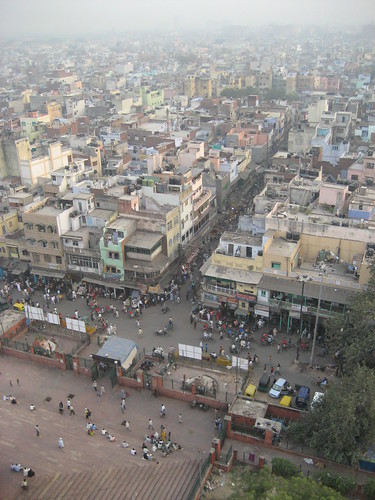
After surviving the minaret mosh pit, I came back down to leave only to find that my shoes were no longer where I put them. I asked every official-looking person I could find about my shoes and they all just laughed at me and told me to go ask someone else. As the mosque shut its doors for the day, I came to grips with the fact that my shoes were gone for good, so I focused on the new problem at hand: finding a shoe store. With the help of a few very nice kids, I only had to go a few barefoot blocks through the filthy streets of Old Delhi before finding an 75-cent pair of flip-flops. Oh well.
To whoever stole my shoes:
1) You are a bastard.
2) There is a $20 bill hidden under one of the soles. Don't spend it all in once place.
3) I stepped in poop several times in those, so technically you are also a poop thief. How do you like them apples?
The next morning, I was up at the crack of dawn to get on my 12-hour daytime train to Bikaner. Seated near me in the train car was this poor Italian guy who was having an absolutely miserable experience in India. During the entire ride, he got hassled like crazy by relentless beggars, little kids wanting to polish his shoes, and people trying to sell him food. Sitting only a few feet away, I was almost completely passed up by all of these people. I don't know exactly what causes it, but the same phenomenon happens to almost everyone I've talked to — after a while of being in India, people just don't hassle you quite as much as they used to.
During the long trip, we passed through gritty cities and the stark Rajasthan countryside, punctuated by women in ultra bright saris, squatting mustachioed men, and kids excitedly waving to the passing train. On the outskirts of most cities lied cluttered, poverty-stricken shantytowns, which were simultaneously intriguing and disgusting, beautiful and horrific.
My first stop in Bikaner was to check out the Karni Mata temple located about 20 miles south of town. The temple is famously known as the place where a small sect of Hindus believes that they will be reincarnated as rats. As a result, the whole temple is swarming with a few hundred of the little rodents, which they regard as their ancestors. These weren't your typical New York City getting-fat-eating-your-delicious-sushi-leftovers-from-the-trash-can rats. These were sickly, scabby rats. Freaky rats. Indian rats. The kind of rats you had nightmares about as a kid. To make a gross thing even more disgusting were that pigeons and flies were everywhere as well, possibly in greater numbers than the rats. Karni Mata had clearly made it a mission to blur the line between Temple and Filthy Creatures Museum.
Despite the temple being completely disgusting, I really enjoyed the strangeness and absurdity of a place where rats are worshipped. A few local kids followed me around the whole time I was there, and insisted I took pictures of them with the rats. During one of my photo shoots, one of the rats pissed all over this kid's shoulder after which he pointed at the pee-stain, laughed and said, "mouse toilet!" Normally I'm pretty tolerant of people's faiths, but if your beliefs push you to the point where you proudly declare yourself a mouse toilet, you've gone off the kooky religious deep-end.
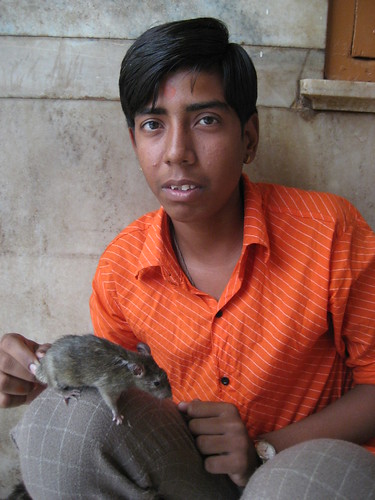
I spent the rest of my time in Bikaner checking out the cool city fort and accompanying museum, which had a surprisingly interesting account of the local British and Indian cultural mixture. My favorite part of the museum were the recreated table settings complete with placards describing the day's meal — from course-to-course was an odd mix of British, French and Indian cuisine. Also in the museum were photos of Indians donning gaudy colonial garb, and Brits dressed in ceremonial Indian costumes, with equally ridiculous-looking results.
One afternoon was spent walking around with a local kid who showed me all of the old havelis (beautiful historic mansions), the wild aromas of the local spice market, and the city's excellent Jain Buddhist Temple. The whole city is fairly tourist-free, which made it easier to meet local people without the fear of being scammed or harassed. Through the traveler grapevine I had heard really negative reviews of Bikaner, but I really liked it there, possibly because I wasn't expecting much. My hostel added to my enjoyment, and was a wonderful change of pace from the awful dump that served as my home in Delhi. Each morning over breakfast, I was treated to phenomenal discussions about global politics with the wise and worldly owner. After long days of sightseeing, I came back for a midnight trifecta of Seinfeld, Friends, and the Simpsons on the tiny TV in my room.
One of the compulsory activities for a traveler in Rajasthan is to go on a camel safari. To avoid sand dunes full of French tour groups and stoned Israeli backpackers, I decided to leave from Bikaner instead of the popular starting point in Jaisalmer. For only 15 dollars per day I was able to hire two huge camels, two guides, cooking supplies and food, a cart to carry everything. My guides were villagers from Deshnok and only spoke a few words of English each, which added to the adventure.
For two days, I rode atop my camel through rural Rajasthan's Thar Desert, past small villages in the barren brush, an amazing array of thatched-roof huts crafted out of the pale mud, and fields of dry looking crops making hearty attempts to grow in the desert climate. In addition to the many domesticated farm animals along the way, the route was also scattered with graceful antelope and fluttering white butterflies. People along the way seemed genuinely surprised to see a white guy in their neighborhood, and they often excitedly ran alongside me as I rode past.
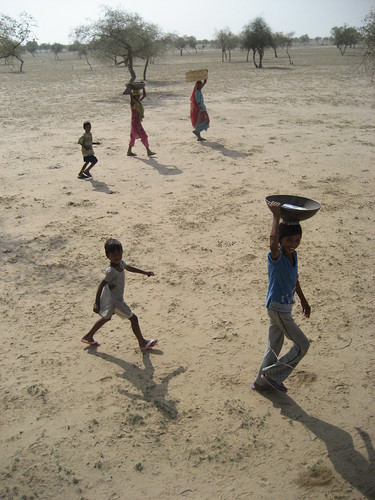
Riding on a camel is not terribly comfortable. In fact, it is a lot like uncontrollably and aggressively humping—in all senses of the word—a big, farting blob on legs. By the time we got to the end of the first day, both the camel and I were exhausted from the days hump-a-thon.
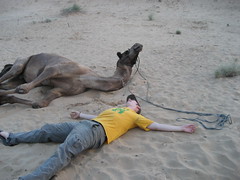
My camel guides cooked our dinner as the sun went down over the dunes. Meals during the journey were a pretty elaborate production, and were surprisingly good. The guys would build a fire from sticks they gathered along the way, and cook up meal of spicy curried vegetables and potatoes over rice. They would add dried camel crap to the fire in order to make the chapati bread, which I did my best to stomach despite it tasting pretty horrible. We'd start and finish each meal with spiced chai tea, which they made out of fresh goats milk. And by fresh, I mean really fresh: whenever we passed a herd along the way we would stop, barter with the herder, and one of the guides would walk over and milk one of the goats.
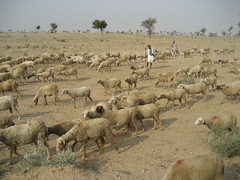
Under a couple of thick blankets, I fell asleep under the bright desert stars, and woke up before dawn to the sounds of my guides already hard at work on breakfast.
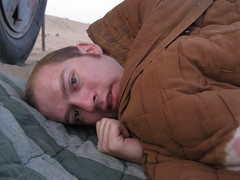
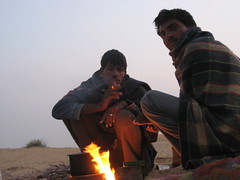
After a long second day on the camel, we made it back to Deshnok where I tipped the guys big and then hopped on the bus back to Bikaner for my night bus headed westbound to Jaisalmer.
Jaisalmer is known in Rajasthan as "the golden city" and when I arrived it became clear why: the entire city is one color. One. No more, no less. The monochromatic golden hue spreads from the houses and havelis in old town, and sweeps up the hill where an awesome sandcastle-like fort sits proudly as it has for almost 900 years.
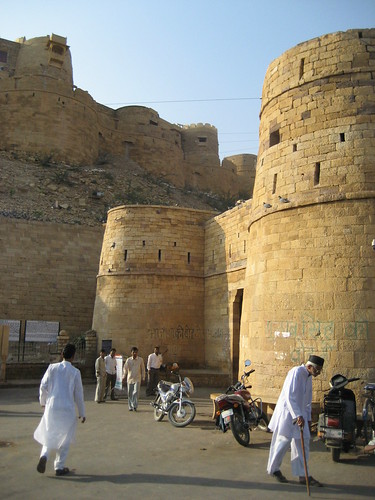
The fort and the rest of the old city are plagued with massive numbers of tourists, more than I've seen in any other Indian city. And while I'm not particularly against tourists (I am one, after all), it does make me uncomfortable to be a part of something that has such a massive effect on a local economy and culture. At the same time, I couldn't help but think that the city is certainly better off now as a tourist trap than it was as a military center when the fort was built — a fort full of tourists is better than a fort full of guns. Despite all the whiteys everywhere, the fort remains a really charming and wonderful place mostly because almost a quarter of the old city's population lives within its walls. I loved wandering its quiet alleyways, browsing its antique stores, and grabbing dinner and a beer looking out over the fort's impressive walls.
Jaisalmer's fort also boasts an awesome group of seven Jain Buddhist temples which were a maze of dusty, dark and intricately carved rooms. When I found myself alone in some of the dimly lit spaces, there was a distinctly Indiana Jones feel about the temples that I really loved.
On the last of my two days in Jaisalmer, I was given a tour around town by a delightful Brahman guy named Madhu, who gave me an insider's look into some of the best parts of the old city, a tour into the city's best havelis, and the city's serene lake. Along the way, we talked about both Indian and American politics, as well as lighter topics like Bollywood. Seeing a Bollywood movie is still on my list of things to do before I leave the country, but his description finally gave me an understanding of what it's all about. Your movie Titanic is Bollywood, sir. Titanic is wonderful. It is about love, heartbreak, passion, caste systems, struggle — everything you could want. If it had singing, it would be the greatest movie ever made. For months, I've been trying to understand the appeal of Bollywood films, and the Titanic-plus-singing comparison was as close as I think I'm going to get.
I left golden Jaisalmer on a bumpy night bus to the significantly larger city of Jodhpur. After some much-needed sleep in the guest house, I wandered outside to check out the city for the first time, and ran right into a parade celebrating a Muslim wedding. Right after I shot the video below, I was dragged into the middle of the circle and became the star of the show. Lucky for me, Indians seem to aspire to dance like nerdy white guys, so it didn't take much to impress the socks off of everyone with my dancing. For the next two days, random people on the street would recognize me and come up to compliment me on my dancing abilities. I've said it before: India is a strange and wonderul place.
Over the course of my two days in Jodhpur, I fell in love with the place. Many of the city's old buildings are painted a bright periwinkle blue shade which live up to its "blue city" name. It's easy to get off the tourist track here, and I spent a lot of time just wandering around checking out the little muslim butcher shops, seeing people weaving baskets or hammering tin pots, and enjoying the overwhelming smell as I walked past Jodhpur's many spice shops. The city also has the most delicious saffron lassis—a thick, spiced yoghurt drink—I've ever tasted.
The highlight of Jodhpur—and the dominating force of the city—is Meherangarh, the mother of all forts. Throughout India, there are a lot of impressive forts. Each city seems to have one. The one in Jodhpur stands as a big middle finger to all the other forts in India. I can imagine enemy soldiers approaching the fort hundreds of years ago getting close to the massive building and saying, well guys, should we... uhhh.... go home now, or what? This thing is that big.
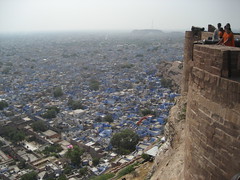
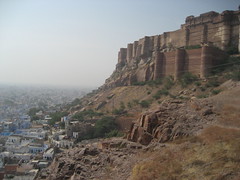
The fort is probably the best preserved building in Asia, and the ticket price comes along with a phenomenal audio guide complete with sounds, music, fascinating descriptions, and interviews with key historians and people involved with the fort's history. After my long day yesterday wandering the complex, I made the long walk beneath its walls where I ended up by myself on the city wall overlooking the old blue town. I sat and watched shadows grow longer and colors brighter listening to the Sigur Ros parenthesis album on my iPod, which perfectly accompanied the breathtaking view. At one point, I just burst out laughing for no reason, just because I felt so amazing being in such an incredible place. It is times that like that which make me travel.
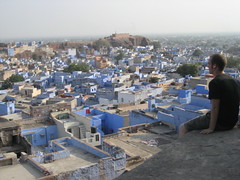
I'm currently in the lake city of Udaipur, which has been great so far. I'm taking a cooking class tomorrow, and I plan on taking a painting class as well, so I've got a few days rest before I resume finish up my whirlwind tour of India in Agra, Varanasi and Calcutta. Thanks for reading, and I'll leave you with the results of my adventures in bovine portraiture:
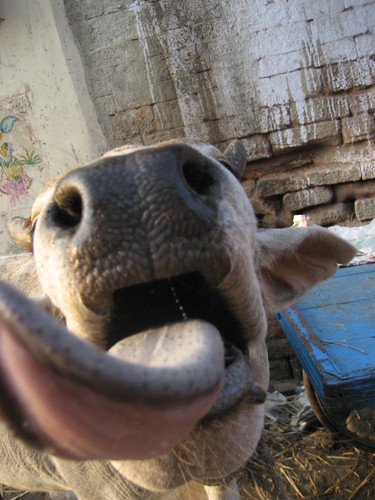
Ryan!
Photos updated: none this time, I only had time to upload the photos in the blog. Sorry!
Also, sorry about the two week wait from the last post. If you are truly desperate to read more travel stories, check out How Conor is Spending All His Money, which gives me serious blog-envy. If you're struggling to wade through his couple hundred posts over the last few years, you could start with this hilarious entry about nuts on an airplane.
2 Comments:
wasn't it scary sitting on the edge of the fort in jodhpur?
Walking around rats with flip flops would not be on my top 10 list. I laughed through your hump-a-thon description. Good writing!
Post a Comment
<< Home